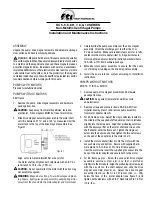
B-30
BOP-1K 091719
FIGURE B-10. USING LIST:WAIT COMMANDS TO CONTROL GENERATION OF A WAVEFORM MEASURED
BY MULTIPLE EXTERNAL DEVICES USING THE LOW-GOING LEADING EDGE OF AN EXTERNAL PULSE
B.102 [SOURce:]LIST:WAIT:LOW COMMAND
LIST:WAIT:LOW
Syntax:
Short Form: LIST:WAIT:LOW value
Long Form: LIST:WAIT:LOW value
where:
<value> = programmed current (Amps) for current list, or programmed voltage (Volts) for voltage list.
Description:
Waits for the trigger input to go low before advancing to next step.
When the command is exe-
cuted the output is immediately set to the <value>. Pins 1 (GND) and 3 of the Trigger Port are used as
the input trigger. If the trigger input is low (TTL logic 0 or short-circuit) and a wait time has been estab-
lished by LIST:SET:WAIT, the step is immediately skipped. If the trigger input is high (TTL logic 1 or
open circuit), the unit will proceed to the next step when either a) the trigger input goes low or b) the
wait time expires (non-zero wait values only), whichever comes first. If the wait time is 0, the unit must
wait until the trigger input goes low before proceeding to the next step.
NOTES: 1. The power supply is assumed to be operating in constant voltage mode.
2. The WAIT commands provide a method to synchronize multiple instruments to a common con-
trol pulse. This example assumes BOP and a number of switching DVMs are connected to a
Unit Under Test (UUT). The DVMs are programmed to wait 1 mS after a low-going edge is
received from the host computer, then take a few measurements. The same low-going edge is
applied to the Trigger Input (pin 3 of the BOP Trigger Port); the negative-going edge of this
pulse will cause the BOP to increment the output to the next level. Thus, each time the host
computer issues a positive pulse, the BOP increments and the DVMs take measurements on
the trailing (negative-going) edge of the positive pulse. The positive pulse can be very short
with this functionality (see Table 1-2, Programming/Display Characteristics - Trigger port - Out-
put On-Off Control Input for minimum pulse width).
3. The explanation below shows how each step of the list functions once the list is entered and
VOLT:MODE LIST (the last step) is executed.
LIST:CLE
Clears the list.
LIST:VOLT:APPLY LEVEL,.001,0
Establishes the list as a voltage list, output set to 0V.
LIST:DWELL:POINTS?
Returns 10. (Wait of 33 mS uses 10 points.)
LIST:WAIT:LEDGE 0
Maintains output at 0V, waits for Input trigger to have a high to low
edge before proceeding.
---
Host computer issues high pulse. Input Trigger goes low at trailing (negative-going) edge of
pulse from host commuter and List proceeds to next point. One mS after pulse issued, DVM
takes measurements.
LIST:DWELL:POINTS?
Returns the current point location (3). (Used for list:repeat.)
LIST:REPEAT 9,10,1.1,2.2,3.3,4.4,5.5,6.6,7.7
Repeats step 9 and 10 (list:volt:apply lev and list:wait:ledge),
except each pair is set to the voltage specified in the array. This
adds 14 points to the list and sets the output values of each pair to
be 1.1V, 2.2V, 3.3V, 4.4V, 5.5V, 6.6V and 7.7V.
LIST:COUNT 2
Implements the waveform through two loops of the data.
CURR 5;:OUTP ON
Set output on, output current to 5A.
VOLT:MODE LIST
Executes the above list. At each high-to-low transition of the Trigger
Port input, the BOP increases its output voltage in 1.1 volt incre-
ments. The duration of each increment is not controlled by the inter-
nal clock of the BOP, but instead by the high-to-low edge of the
pulse from the host computer.
Summary of Contents for BOP-ME 1KW
Page 2: ......
Page 20: ...xii BOP 1K 091719 FIGURE 1 1 HIGH POWER BOP SERIES POWER SUPPLY...
Page 42: ......
Page 64: ...2 22 BOP HIPWR 091719 FIGURE 2 11 PARALLEL CONFIGURATION LOCAL SENSING TYPICAL...
Page 65: ...BOP HIPWR 091719 2 23 FIGURE 2 12 PARALLEL CONFIGURATION REMOTE SENSING TYPICAL...
Page 76: ......
Page 161: ...BOP HIPWR 091719 3 85 FIGURE 3 29 STATUS REPORTING STRUCTURE...
Page 164: ......
















































